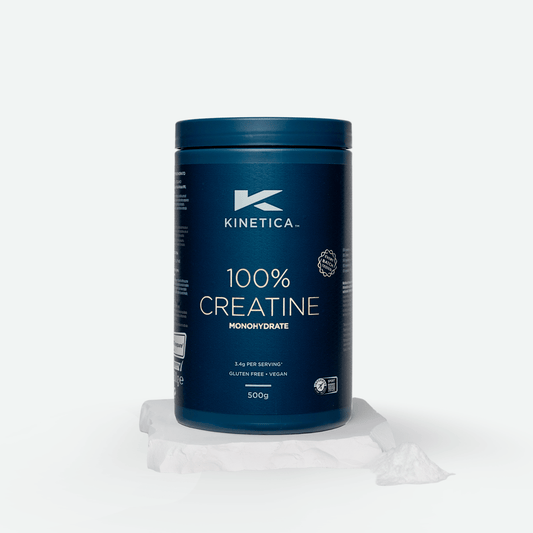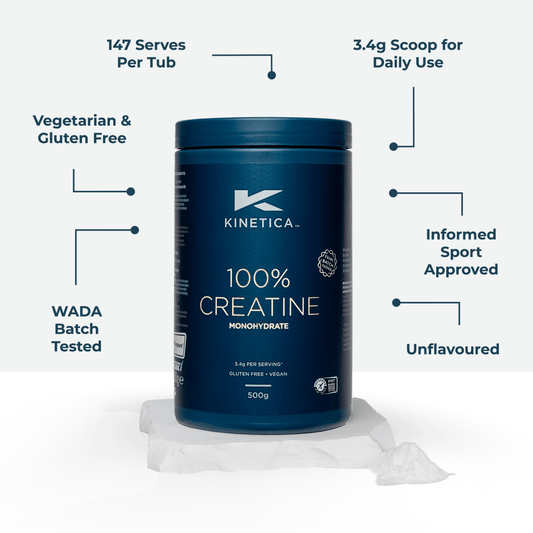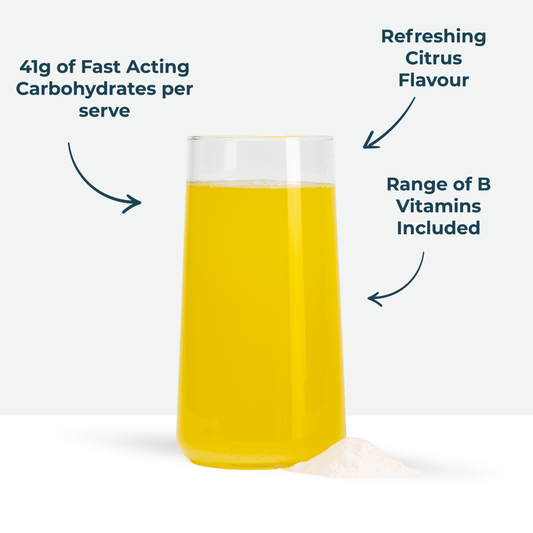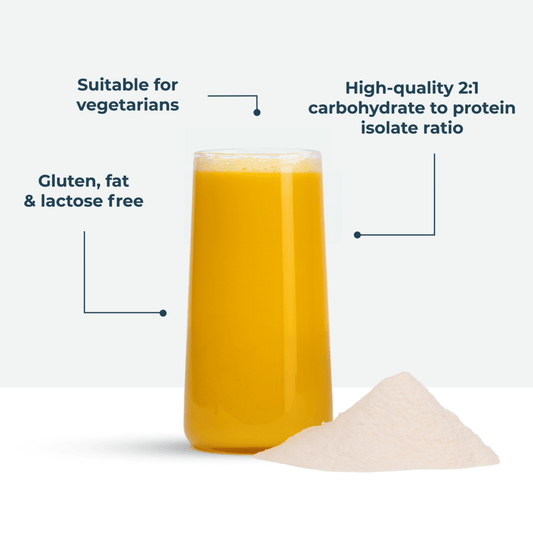Tailoring Nutrition Plans for Different Positions in Football

Football is one of the most loved sports on the planet, with over 240 million registered players worldwide. It’s also a sport that is constantly evolving. If you are a fan, you will have seen how players at the top level are adapting, becoming fitter, faster and more athletic than ever before.
Research suggests that the game is increasingly demanding. Players are covering greater distances on the pitch in a game and performing more hard sprints, too. For example, a recent systematic review found that sprint distances - where players run over 25.1 kph - have increased by 50% in the last 15 years (Gualtieri, Rampinini et al. 2023).
This is one of football's beautiful features—you not only need excellent technical skills, such as dribbling and passing, but also a range of athletic qualities, such as aerobic fitness, anaerobic fitness, acceleration, deceleration, top-end speed, jumping, and the capacity to change direction explosively and regularly throughout a match. A player is estimated to perform 1000-1400 short activities with changes of movement every 4-6 seconds of a game (Stølen, Chamari et al. 2005).
In response to the game's growing demands, professional footballers are meticulous in their pre-match preparation, post-match recovery, and overall health for performance. Nutrition is vital here. Fuelling the body through appropriate diet and hydration is a core foundation for high performance in football. It does not matter how skilful a player might be; they can only express their potential when cells, systems and the brain are adequately fuelled.
In my work with professional footballers, we go to great lengths to ensure a personalised and proactive approach to nutrition—leveraging lab data to understand their specific needs and digital biomarkers to see how well they adapt to load over a season.
Unfortunately, many amateur players are unsure about the role of nutrition in the game, which can hinder performance on the field. In this blog, I’d like to change that. If you are passionate about the game, you will find some basic but vital strategies to help you below. We’ll look at diet, supplementation and hydration, with a nod towards different positions on the pitch. Let’s jump in!
The Challenge
When it comes to improving football performance, simple changes can make a big difference. Take dehydration for example. A football player can lose between 500ml and 3 litres of body fluids during training and matches, depending on the intensity of exercise and environmental conditions (Mohr, Nolsoe et al. 2021).
Recent studies have also shown that many football players who enter a match are already poorly hydrated. For example, one paper found that between a third and two-thirds of players began a game without being sufficiently hydrated (Chapelle, Tassignon et al. 2020).
Hydration is naturally just one piece of the nutrition puzzle in football, but it matters greatly. Dehydration is a stress on the body and that causes a rise in cortisol levels, amongst other things (Castro-Sepulveda, Ramirez-Campillo et al. 2018).
The authors of a recent meta-analysis summed it up well when they wrote, “When hypohydrated soccer players have significantly higher heart rates, ratings of perceived exertions, blood lactate levels and body core temperatures. Regarding soccer performance, hypohydration is reported to cause a significant decrease in aerobic performance, dribbling skills, sprint performance and cognitive skills.” (Chapelle, Tassignon et al. 2020).If you take a moment to think about it, this is a big deal. Going into a match dehydrated and then continuing that deficit in a game can hit everything:
- Heart rate goes up, which means you can fatigue quicker.
- Levels of exertion go up, which means the match feels tougher.
- Lactate levels are higher, so you recover slower between sprints.
- Dribbling skills are less effective, so when you do get the ball, you cannot express your talent in the same way.
- Cognitive skills are blunted, which means that decision-making at critical moments can be impaired.
These issues can become even more pronounced based on factors such as air temperature, humidity and your position on the field (Sekiguchi, Adams et al. 2019).
It is worth noting the effect of different playing positions here. The overall load on a player during a game depends partly on where you play on the pitch. For example, goalkeepers cover significantly less ground than outfield players - about 4-6 km per match versus 10-12 km (Anderson, Drust et al. 2022).
Outfield players also perform differing levels of work. Research shows wide midfielders and central midfielders cover a greater distance during a match than fullbacks, attackers, and central defenders, and they also perform more high intensity running. This can have implications for fluid loss and nutritional needs (Bradley, Di Mascio et al. 2010).
The Solution
Let’s give you some solutions for your diet and hydration.Step 1: Diet strategies
When thinking about nutrition for football, it is helpful to break down fuelling strategies into three blocks around match day:
- The 24 hours before you play (MD-1)
- Match day (MD)
- The 24 hours after you play (MD+1)
As you might imagine, this blog post does not have sufficient word count to give you a deep dive into the macronutrient needs for each day and for different playing positions. However, it’s worth emphasising one quick win and a vital piece of the jigsaw here: carbohydrate intake.
Given the exercise intensity of football, muscle glycogen (this is your stored form of carbohydrate) is the primary source of energy production (van Loon, Greenhaff et al. 2001). In fact, by the end of a game, around 50% of muscle fibres can be either completely empty or partially depleted of glycogen (Krustrup, Mohr et al. 2006).
Why does this matter? Loss of glycogen prevents muscles from working as effectively as they need to and has been linked to the development of fatigue in a game. As such, it’s vital to ensure you go into a match with adequate glycogen to fuel performance and replenish it quickly afterwards.
When I consult players, I often help them periodise their carbohydrate intake according to daily needs. This allows them to fuel up for performance as needed whilst keeping on top of caloric intake and body composition needs. Research supports adjusting your carbohydrate intake for football based on daily needs (Anderson, Drust et al. 2022, Fernandes 2022).
The authors of one paper described it this way, "In English Premier League soccer players, training load was quantified during one, two, and three-game week schedules. Muscle glycogen is the main energy source for football match play, but its importance for football training is not well known. Daily carbohydrate intake should be periodized according to weekly training and match schedules to improve physical match performance and training adaptation." (Anderson, Orme et al. 2016)
To fuel up for a game, use these numbers as a starting point and adjust based on real-world experience. This advice comes from a UEFA expert group statement on nutrition in elite football (Collins, Maughan et al. 2021).
MD-1: Training is usually light on the day before a match, and carbohydrate intake should be 6–8 g/kg body mass to elevate muscle and liver glycogen stores. For example, if you weigh 75kg, you will take on between 450 g and 600 g of carbohydrates. These are quite large amounts of carbohydrate to consume so to make life easier, Kinetica Sports’ Energy powder can be a convenient carbohydrate option to help you meet these targets.
MD: On match day, carbohydrate intake is a crucial consideration. Within an overall guideline of 6–8 g/kg carbohydrate per day, it is recommended that players consume a carbohydrate-rich meal (1–3 g/kg BM) 3–4 hours before kick-off to ensure that they begin the match with adequate glycogen stores. During the game, it’s recommended that about 30–60 g of carbohydrates is consumed after warm-up and again at half-time to meet needs. Sports gels, like Kinetica Sports Energy or Energy + Caffeine gels are a good option here if your gut tolerates them well, as well as high-carbohydrate sports drinks or Kinetica Sports Energy powder as mentioned above.
MD+1: After a competitive match, aiming for a quick recovery option is important. One crucial aspect of this is to refill carbohydrate stores rapidly. Therefore, post-match meals and snacks should focus on consuming approximately 1 gram of carbohydrates per kilogram of body weight per hour for 4 hours. One way to help initiate this process is to include Kinetica Sports’ Recovery option in your refuelling and repair strategy. Here you’ll get 41g of carbohydrates per serving as well as 22g of protein.
Personalising your approach: These recommendations are for elite-level athletes who will cover a lot of ground and play at very high levels of intensity overall compared to the amateur game. As such, this carbohydrate level might not be needed, so please adjust as required. Also, if you play in goal or do not cover as much distance on the pitch due to your tactical role in the team, you can start on the lower side of recommendations and adjust as needed based on your match-day energy and performance and body composition over time.
Step 2: Hydration strategies
As outlined above, maintaining hydration and electrolyte status helps health and performance. How you achieve this can vary according to the outside temperature, how acclimatised you are to the environment, and your personal needs.
Because sweating is the primary way to regulate body temperature and dissipate the metabolic heat generated during strenuous exercise, your aim should be to go into a match fully hydrated. An excellent way to do this is by getting on top of fluid intake in the days before you compete (Mohr, Nolsoe et al. 2021).
MD-1: The hydration process starts well before you take the field. In the 24 hours before your game, ensure you drink plenty of high-quality mineral water, aiming for light yellow or straw-coloured urine. Check your body weight first thing in the morning after waking to see if it is normal.
MD: On the day of the game, it has been suggested to consume 5-7 ml per kg of body weight 4 hours before the match and then another 3-5 ml per kg 2 hours before the game (Fernandes 2022). For example, if you weigh 75kg, that will equate to 375-525ml and 225-375ml, respectively.
MD+1: After the game, shoot for 1.5 litres of water for every kilo of body weight lost (Fernandes 2022). This might include a sports drink immediately after the final whistle to replenish fluid and glycogen stores. Keep drinking high-quality mineral water after that until urine is light in colour and body weight has normalised. Adding something like Electro-C to your water can help replenish your electrolyte stores too and support an effective rehydration strategy too.
Personalising your approach: Everyone has a different sweat sensitivity, which impacts how much fluid you might lose in any match (Montain, Latzka et al. 1995). As such, with any general recommendation, the most important thing you can do is test in the real world and adjust as needed.
There are many ways to assess hydration status, from low-tech to high-tech methods. The simplest way (still commonly used in my experience with Premiership and Bundesliga players) is to ensure your body weight is the same going into a match. If your body weight is lower, you may be dehydrated. If it is higher, you may be hyperhydrated.
Urine colour and smell can add to this picture; the darker and more pungent the urine, the more dehydrated you are. The goal is to optimise body weight and ensure your urine is light in colour.
Please note: Avoid relying on thirst as a barometer for hydration status. Why? There is a lag effect to thirst, and if you are thirsty, you are already dehydrated which can lead to significant issues on game day. Research has found that losing 2% of body mass to hypohydration puts you at a higher risk of poorer performance (McGregor, Nicholas et al. 1999).
Step 3: Supplement Strategies
A final part of the picture that is worth considering, to improve performance on the pitch is dietary supplements from Informed-Sport, WADA-compliant brands like Kinetica Sports. There are a variety of supplements commonly used by footballers at an elite level (Fernandes 2021, Close, Kasper et al. 2022). This includes:
- Creatine – to promote athletic performance.
- Whey – to meet daily protein needs.
- Caffeine – to support focus on game day.
- Sodium bicarbonate – to support training adaptations.
- Nitrate (beet juice) - to support cardiovascular performance.
- Probiotics – to support immunity.
- Vitamin D – to support immunity.
- Zinc lozenges – to support immunity.
- Collagen – to support ligament, joint and tendon health and musculoskeletal adaptation.
- Beta-alanine – to support athletic performance.
Please take your time to implement these dietary, hydration, and supplement strategies. Also, let me know about your success! I would love to hear you fine-tune these tactics for your needs.














